Compass:C - a'
Size: 680mmL x 564mmW x 215mmH
General description:
The original idea was in the Leonardo da Vinci's notebook. The first geigenwerk
was made by Hans Haiden in Nuremberg in 1600. Since then, a number of different
shapes of mechanically bowed keyboard instruments were designed and made
by different makers over the last 400 years. Since 1993, I have been challenging
in making Geigenwerks and a Streichklavier. The whole purpose of this effort
is to realize a keyboard instrument which can produce a profile in each
tone of melodic lines, by modulating dynamics and tone pitch.
In designing this violaorganista, the key concept was to imitate the sound
generating principle of a violin. The violin strings are used. The bowing
position and location of the bridge relative to the string length are exactly
the same of those of violin. While depressing a keyboard, the corresponding
string comes to contact against the rotating friction wheel, providing
dynamics modulations with the finger pressure. Mechanisms which can move
the strings up and down with the rotating levers are mounted on blocks
similat to the tail peice of a violin. The string moves up/down, rubbing
vertical edge (strictly speaking a partial circle) of the bridge giving
a slight side bearing to the bridge. To provide the lowest note of C, viola
strings are used in addition to the violin strings for the other notes.
Additional tensile force to the string when the key lever is depressed
results lifting sound pitch. Through previous experiences with the geigenwerk,
it was recognized that providing pitch control ability to the player was
too much freedom and it was impractical to control tone pitches of all
tones in a harmony. Then the rotating lever, invented when the streichklavier was designed, was employed, so that the player can concentrate dynamic modulations with minute change of tone pitch.
![]()
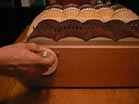
![]()
![]()
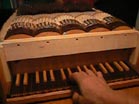
![]()
![]()
![]()
![]()
![]()
![]()
![]()
![]()
![]()
Modulation with wheel rotation speed.![]() Vibrato with finger pressure.
Vibrato with finger pressure.![]() Crescendo/Diminuendo
Crescendo/Diminuendo![]()
![]() Mozart K.3
Mozart K.3
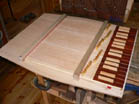
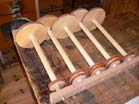
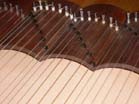
![]()
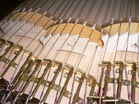
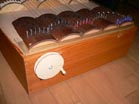
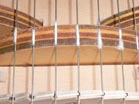 AMIS Meeting Slides
AMIS Meeting Slides
![]()
![]()
![]()
![]()
![]()
Compass: C - f'''
Size: 1572mmL x 860mmW x 260mmH
General description of the instrument
For a Geigenwerk, wich has friction material (parchment or horsehair) on
a circumferential edge of a circular disk, the friction material is supported
with hard material (wood or metal). Instead of using friction wheels,
Streichklavier employees an endless belt like structure of friction material, which has no supporting material on the back side
of the friction belt, imitating regular bow of the violin family string
instruments. The compass of four and half octaves is divided into
6 portions and each one of the friction belt is to play 9 notes.
This is because of 1. Providing slower bow movement for lower tones and
faster movement for higher tones, like playing violin family instruments
and 2. Preventing large deformation of friction belt when higher pressure
is applied between the string and the friction belt. A mechanism
to have strings contacted to the rotating friction belt is, of course,
linked with the keyboard action. To produce louder tones, higher
pressre is applied between the strings and the friction belt. A special lever structure is designed to apply higher pressure without modifying the string tension.
When a loosely set string is pulled in a direction perpendicular to its tension and the pulling pint is rotated around a point on the straight line between the bridge pin and nut pin, string tension is not changed. This rotating motion can be used to move the string down to contact against
the rotating bow.
Then, loudness modulation, corresponding to the pressure between the string
and the rotating bow, can be obtained without modifying the tone pitch.
A rotating lever to move the string down to contact against the rotating
bow can be found in the Truchado’s instrument and figures of Hyden’s
instrument in the Syntagma Musicum by M. Praetorius.
However, if these reference materials are carefully examined, it can be
found that the string tension is also modified when the rotating lever
presses down the string against the rotating bow.
The axis of the rotating lever and the straight line between the bridge
pin and the nut pin do not align in the same line. Moreover, in the Truchado’s instrument, although it is also obvious from
the plan view, the nut rail is positioned no less than 5mm higher than
the base block of the rotating lever. This implies the rotating lever, used in this
instrument, is not with an intention of keeping the string in a constant
tension when it is pressed against the rotating bow.
In order to provide an easy maintainability for replacement of friction
belt, the sub-assembly of 6 friction belt units can be detached from the
bottom of the instrument body. The string tension is supported with the
frame structure, not with the bottom board.
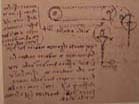
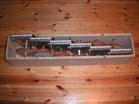
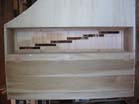
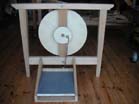
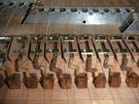
Geigenwerk II
Size: 1430mmL x 871mmW x 300mmH
Aim for the new version
When the first prototype was made in 1993, several potential capabilities of Geigenwerk were pointed out: long tone sustaining, forte/piano expressions, vibrato and fine adjustment of tone pitch. Although all of these features could be demonstrated, the instrument still had some problems to be improved: difficulties in playing fast passage in lower tones, unstable starting up of sound and impracticality of instantly adjusting pitches of all individual tones of a chord, based on natural harmonics. Moreover, from one of the descriptions of the instrument made by Hans Haiden (or Hyden)*1, it seemed to be able to quickly control forte/piano and could emphasize any part in a harmony. Adding these features is also included in the aim of making this new version.
Reference:
1.Mitsugu Yamada: "Bach and Lautenclavier -seeking lost instruments-" Symphonia Co., Ltd. March 2001, p.72 to 73 (sorry, Japanese only)
Results of modifications:
Major modifications after the first prototype:
1. Parchment replaced with horsehair
 Rotating friction wheels, covered with parchment, is good enough when used
in a hurdy-gurdy mode, where strings are already in contact with the friction
wheel when the wheel starts rotating. However, in the Geigenwerk,
where strings come in contact to the rotating wheel to start producing
sound, it was not so easy to produce stable start up of sound, which might
be due to uneven friction coefficient of parchment. Instead, horsehair
show very stable start up of sound over the entire range of the compass.
In the maintenance point of view, however, sometimes horsehair drop from
the rim of the friction wheel. Once the horsehair dropped, they tangle
each other, and require entire bundle of the horsehair need to be
replaced. In order to avoid this problem, thickness of the
friction wheel was increased.
Rotating friction wheels, covered with parchment, is good enough when used
in a hurdy-gurdy mode, where strings are already in contact with the friction
wheel when the wheel starts rotating. However, in the Geigenwerk,
where strings come in contact to the rotating wheel to start producing
sound, it was not so easy to produce stable start up of sound, which might
be due to uneven friction coefficient of parchment. Instead, horsehair
show very stable start up of sound over the entire range of the compass.
In the maintenance point of view, however, sometimes horsehair drop from
the rim of the friction wheel. Once the horsehair dropped, they tangle
each other, and require entire bundle of the horsehair need to be
replaced. In order to avoid this problem, thickness of the
friction wheel was increased.
2.Cat skin on the strings
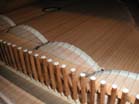 A
sharp start up of sound is available with a thin small piece of cat skin adhered
on the strings where the circular bow with horsehair is applied. With the
cat skin, tremolo and fast trill can be played with no difficulty. The
thin cat skin is originally prepared for a Japanese authentic plucking
instrument, Shamisen.
A
sharp start up of sound is available with a thin small piece of cat skin adhered
on the strings where the circular bow with horsehair is applied. With the
cat skin, tremolo and fast trill can be played with no difficulty. The
thin cat skin is originally prepared for a Japanese authentic plucking
instrument, Shamisen.
3. Sliding nut pins
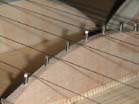 In the previous
prototype, tone pitch adjustment and vibrato were controlled by changing string
tension, keeping the constant pressure between strings and the friction
wheel. In this configuration, though rather stable tone quality
could be obtained, dynamic expression was only controlled by tangential speed
of the friction wheel. To provide a wider dynamic range, it was
experimentally found that changing pressure between string and the friction wheel works much
better than changing the rotation speed of the wheel. To adjust
pressure between the string and the friction wheel, either moving the wheels or
the strings up and down is necessary. If the wheel was moved,
dynamics of the chord could be controlled but single part of the chord can not
be emphasized. A mechanism was invented to slide the strings up and down on the nut
pin. When the string is pressed down, string goes down, rubbing the nut
pin, where the string is acoustically terminated. (Click here
for drawing)
In the previous
prototype, tone pitch adjustment and vibrato were controlled by changing string
tension, keeping the constant pressure between strings and the friction
wheel. In this configuration, though rather stable tone quality
could be obtained, dynamic expression was only controlled by tangential speed
of the friction wheel. To provide a wider dynamic range, it was
experimentally found that changing pressure between string and the friction wheel works much
better than changing the rotation speed of the wheel. To adjust
pressure between the string and the friction wheel, either moving the wheels or
the strings up and down is necessary. If the wheel was moved,
dynamics of the chord could be controlled but single part of the chord can not
be emphasized. A mechanism was invented to slide the strings up and down on the nut
pin. When the string is pressed down, string goes down, rubbing the nut
pin, where the string is acoustically terminated. (Click here
for drawing)
4. Minimal down bearing
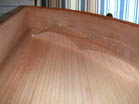 In the most of
keyboard instruments, both down bearing and side bearing are applied by
geometrical positions between bridge pins and hitch pins. In the case of R.
Truchado's instrument, flat hitch pin rail, like one for harpsichord, is
used. In such configuration, each string, in a set of string group for one
friction wheel, has different down bearing. Typically in the center of the
convex soundboard bridge, down bearing is as mush as 35 to 40 mm. The clearance
between strings and a friction wheel is typically 1mm and large down bearing may
cause the soundboard bridge to sink down, causing miss alignment between the
circular friction wheel and strings more severely in the higher notes. Though it is inevitable
to have small amount of moving up and down of the soundboard bridge due to
humidity change, minimal down bearing, as little as 1mm, is applied with
circular shaped hitch pin rail to prevent bridge from sink down due to the
string tension. Acoustical coupling between the strings and the soundboard
bridge is applied mostly with the side bearing.
In the most of
keyboard instruments, both down bearing and side bearing are applied by
geometrical positions between bridge pins and hitch pins. In the case of R.
Truchado's instrument, flat hitch pin rail, like one for harpsichord, is
used. In such configuration, each string, in a set of string group for one
friction wheel, has different down bearing. Typically in the center of the
convex soundboard bridge, down bearing is as mush as 35 to 40 mm. The clearance
between strings and a friction wheel is typically 1mm and large down bearing may
cause the soundboard bridge to sink down, causing miss alignment between the
circular friction wheel and strings more severely in the higher notes. Though it is inevitable
to have small amount of moving up and down of the soundboard bridge due to
humidity change, minimal down bearing, as little as 1mm, is applied with
circular shaped hitch pin rail to prevent bridge from sink down due to the
string tension. Acoustical coupling between the strings and the soundboard
bridge is applied mostly with the side bearing.
5. Tangential velocity of friction wheel
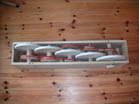 In the
previous prototype, all friction wheels are rotated with the same tangential
speed. As a result, strings could not smoothly start vibration in the lower notes,
because of too fast tangential speed of the circular bow. On
the other hand, in higher notes, rather faster speed is needed to have smooth
tone quality. Thus, as seen in R.Truchado's instrument, sizes of the pulleys
are adjusted to provide fast rotation for higher notes and slower rotation for
lower notes. Typically, the rotation speed of the friction wheels
are 70% of that of immediate next right of the one.
In the
previous prototype, all friction wheels are rotated with the same tangential
speed. As a result, strings could not smoothly start vibration in the lower notes,
because of too fast tangential speed of the circular bow. On
the other hand, in higher notes, rather faster speed is needed to have smooth
tone quality. Thus, as seen in R.Truchado's instrument, sizes of the pulleys
are adjusted to provide fast rotation for higher notes and slower rotation for
lower notes. Typically, the rotation speed of the friction wheels
are 70% of that of immediate next right of the one.
6. Pressed down strings and location of the keyboard
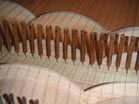
 With normal
keyboard, when key is depressed, the other end goes up. It is not easy to
use this type of keyboard for the geigenwerk, which requires strings to go down
against the friction wheel, when key is depressed. Though a special
mechanism was designed for the previously made prototype, this time, keyboard is
located above the strings, eliminating the complex mechanism. With this configuration, more direct feedback from
string vibrations to the player's finger is provided, allowing more direct
contact between
the player and the instrument. When the key lever is depressed, string is pressed down with a push rod,
which is hanging on each string, then the string contacts with the friction
wheel.
With normal
keyboard, when key is depressed, the other end goes up. It is not easy to
use this type of keyboard for the geigenwerk, which requires strings to go down
against the friction wheel, when key is depressed. Though a special
mechanism was designed for the previously made prototype, this time, keyboard is
located above the strings, eliminating the complex mechanism. With this configuration, more direct feedback from
string vibrations to the player's finger is provided, allowing more direct
contact between
the player and the instrument. When the key lever is depressed, string is pressed down with a push rod,
which is hanging on each string, then the string contacts with the friction
wheel.
7. Monolithic soundboard bridge
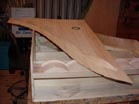 Instead of having
four soundboard bridges corresponding to the four friction wheels, a monolithic soundboard bridge was
designed.
It helps leveling soundboard deformations, which are due to string tension,
temperature and humidity changes.
Instead of having
four soundboard bridges corresponding to the four friction wheels, a monolithic soundboard bridge was
designed.
It helps leveling soundboard deformations, which are due to string tension,
temperature and humidity changes.
8. Driving mechanism of rotating wheels
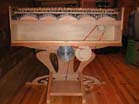 In the previously
made instrument, a bicycle pedal like treadle was used to rotate friction wheels
and as mentioned in the above section 2, tangential speed of the friction wheel
was assumed to be a factor of musical expression. However, it was found to
be impractically difficult for players to adjust the speed of the wheel,
while playing a manual keyboard. This time, rotation speed of the
friction wheel does not contribute to musical expressions and dynamic expression
is given only by changing the pressure between strings and the friction
wheel. A flywheel, just like a wind chest of an organ, is employed and an
old sawing machine like pedal is used to provide torque to keep the flywheel
rotation.
In the previously
made instrument, a bicycle pedal like treadle was used to rotate friction wheels
and as mentioned in the above section 2, tangential speed of the friction wheel
was assumed to be a factor of musical expression. However, it was found to
be impractically difficult for players to adjust the speed of the wheel,
while playing a manual keyboard. This time, rotation speed of the
friction wheel does not contribute to musical expressions and dynamic expression
is given only by changing the pressure between strings and the friction
wheel. A flywheel, just like a wind chest of an organ, is employed and an
old sawing machine like pedal is used to provide torque to keep the flywheel
rotation.
Compass: F - f'''
Size: 1280mmL x 770mm W x 257mmH
REPORT: Making a Bowed Keyboard Instrument
Reference:
1. Emanuel Winternitz, Leonardo da Vinci as a Musician (New Haven and London: Yale University Press, 1982)
2. Michael Praetorius, Syntagma musicum, Vol.2: De organgraphia, trans. and ed. by D. Z. Crookes, Early Music Series,
no.7 (Oxford: Clarendon Press, 1986)
3. Ferdinand Joseph De Hen, "The Truchado Instrument: A Geigenwerk?" in Keyboard Instrument: Studies in Keyboard
Organology, ed. Edwin M. Ripin (Edinburgh: Edinburgh University Press, 1971)
4. Sibyl Marcuse, A Survey of Musical Instruments (New York: Harper & Row, 1975)
5. Carolyn W. Simons, "Some Nineteenth-Century Mechanically Bowed Keyboard Instruments in European Museums," a
paper presented 15 May 1993 at the National Meeting of the American Musical Instruments Society in Nashville, Tennessee
With kind support by Mr. Nicola Meeus, the curator of the Brusseles Conservatoire Museum, the builder was given an
opportunity to investigate detailed interior of the instrument made in 1625 by Fray Raymundo
Truchado.
Model: This instrument is not a replica of any historically existed instrument.
Though it is regularly performed by string and wind instruments players, there is no single keyboard instrument which can
allow the player to perform all of the below mentioned very important music expressions including, sustaining the tone as
long as necessary, increasing the dynamics after the tone released, performing vibrato and making fine adjustment of pitch.
Geigenwerk has a great potential to satisfy all of these requirements at a time.
The historical origin of this instrument can be traced back to Leonardo da Vinci. Leonardo drawn several sketches
describing the idea of this type of musical instrument and named them as Viola organista.
Simons categorized this type of instruments in three groups for its tone generation mechanism, such as, Geigenwerk,
Streichklavier and Piano-quatuor.
Since Leonardo da Vinci drawn the sketches, about 90 people attempted
to make it or applied patents in the last 500 years. Curiosity about the
performance possibilities and general practicality of the Geigenwerk, the
builder designed and constructed an instrument based on historical examples.
Unfortunately, at present, with the issues mentioned below, the quality of the instrument is not good enough to motivate
composers and players to make music.
1. It is difficult to play fast passages in lower tones.
2. Build-up of the tone is not always stable and reliable.
3.Considerable skill is required for players to instantaneously adjust tone pitch of harmonies.
The work of making this experimental instrument was presented in May 1993 at the national meeting of the American Music
Instrument Society in Nashville, Tennessee. Since then, the instrument has been continuously modified for improvement.